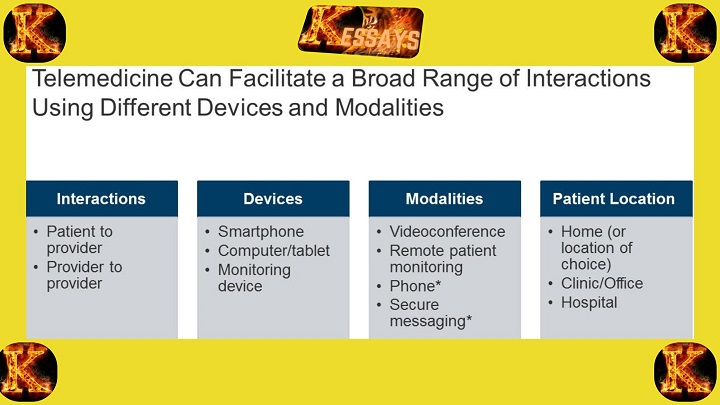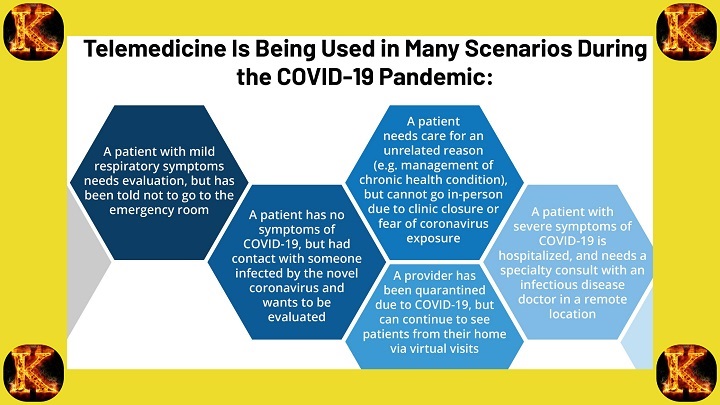Introduction to Telehealth Services
In recent years, telehealth services have emerged as a game-changer in healthcare, revolutionizing how medical services are accessed and delivered. Telehealth refers to using digital communication technologies to provide remote
healthcare services, enabling patients to consult with healthcare professionals from the comfort of their homes. This essay will explore the importance of telehealth services in healthcare and how they enhance access, improve patient outcomes, and transform the healthcare landscape.
I. Enhancing Access to Healthcare
1.1. Overcoming Geographic Barriers
Telehealth services play a crucial role in overcoming geographic barriers to healthcare access. In remote and underserved areas, where access to healthcare facilities may be limited, telehealth bridges the gap by connecting patients with healthcare providers remotely. Through virtual consultations and remote monitoring, individuals can receive timely medical advice, diagnosis, and treatment without the need to travel long distances.
1.2. Improving Access for Vulnerable Populations
Telehealth services are particularly beneficial for vulnerable populations, including the elderly, individuals with mobility limitations, and those living in rural or isolated communities. These individuals often face significant challenges in accessing healthcare due to physical limitations, lack of transportation, or limited healthcare infrastructure. Telehealth services enable them to receive necessary care, manage chronic conditions, and access specialist consultations conveniently and efficiently.
Telehealth services have the potential to overcome language and cultural barriers that may impede access to healthcare. With the use of interpreters or language translation services, telehealth allows healthcare providers to communicate effectively with patients who speak different languages. This ensures that language barriers do not hinder individuals from receiving the care they need. Additionally, telehealth can be adapted to accommodate cultural sensitivities and practices, promoting culturally appropriate care for diverse populations.
1.4. Expanding Access to Specialized Care
Telehealth services expand access to specialized care for individuals in remote or underserved areas. By connecting patients with healthcare providers who specialize in specific
medical fields, telehealth eliminates the need for patients to travel long distances to access specialized care. This is particularly beneficial for individuals who require consultations with experts in rare diseases, complex conditions, or specialized treatments, ensuring they receive the highest level of care regardless of their location.

II. Transforming Healthcare Delivery
2.1. Timely and Convenient Care
Telehealth services provide patients with timely and convenient access to healthcare. Through virtual consultations, patients can connect with
healthcare professionals quickly, reducing wait times for appointments and avoiding unnecessary visits to healthcare facilities. This is especially valuable in non-emergency situations, where patients can receive advice, prescriptions, and follow-up care remotely, eliminating the need for in-person visits.
2.2. Continuity of Care
Telehealth services contribute to improved continuity of care, ensuring seamless transitions between different healthcare settings. By enabling healthcare providers to communicate and share patient information electronically, telehealth facilitates coordinated and collaborative care. This is particularly beneficial for patients with chronic conditions who require ongoing monitoring and management. Telehealth allows healthcare teams to track patient progress, adjust treatment plans, and provide timely interventions, leading to better
health outcomes.
2.3. Improved Care Coordination
Telehealth services enhance care coordination among healthcare providers, leading to more effective and efficient healthcare delivery. With telehealth, healthcare teams can communicate and collaborate in real-time, sharing patient information, test results, and treatment plans seamlessly. This improves the continuity of care across different healthcare settings and ensures that all providers involved in a patient's care are well-informed and can make informed decisions.
2.4. Remote Specialty Consultations
Telehealth services enable remote specialty consultations, bringing specialized expertise to patients regardless of their geographical location. Patients can access consultations with specialists, such as cardiologists, neurologists, or oncologists, without the need for travel. This ensures that patients receive timely and accurate diagnoses, appropriate treatment recommendations, and access to specialized knowledge that may not be available locally.
2.5. Efficient Healthcare Resource Allocation
By integrating telehealth services into healthcare delivery, resources can be allocated more efficiently. Virtual consultations and remote monitoring allow healthcare providers to prioritize in-person visits for patients who require physical examinations or procedures, optimizing the utilization of healthcare resources. Telehealth also reduces the strain on emergency departments by providing an alternative for non-emergency conditions, diverting unnecessary visits and allowing emergency resources to be dedicated to critical cases.
III. Enhancing Patient Outcomes
3.1. Preventative Care and Health Monitoring
Telehealth services empower individuals to engage in
preventative care and health monitoring, leading to improved patient outcomes. Through remote monitoring devices and telehealth platforms, patients can track vital signs, manage chronic conditions, and receive personalized health education and support. Early detection of health issues and timely interventions can prevent complications, reduce hospitalizations, and promote overall well-being.
3.2. Patient Engagement and Empowerment
Telehealth services encourage patient engagement and empowerment in their healthcare journey. Through virtual consultations, patients have the opportunity to actively participate in their care, ask questions, and discuss treatment options with healthcare professionals. This collaborative approach enhances patient satisfaction, adherence to treatment plans, and overall engagement in self-care, leading to better health outcomes and improved quality of life.
3.3. Improved Health Outcomes for Rural and Underserved Populations
Telehealth services have shown promising results in improving health outcomes for rural and underserved populations. These communities often face challenges in accessing timely healthcare due to limited healthcare facilities and healthcare provider shortages. Telehealth bridges the gap by connecting patients in remote areas with healthcare professionals, enabling timely interventions and reducing health disparities. By receiving prompt care and ongoing monitoring, individuals in rural and underserved areas can experience improved health outcomes and a better overall quality of life.
3.4. Reduced Hospital Readmissions
Telehealth services play a significant role in reducing hospital readmissions, particularly for patients with chronic conditions. Through remote monitoring and virtual follow-ups, healthcare providers can closely monitor patients' health status and detect any signs of deterioration. Early interventions and adjustments to treatment plans can be made, preventing unnecessary
hospital readmissions. By facilitating proactive and continuous care, telehealth contributes to better management of chronic conditions, reducing the burden on healthcare facilities and improving patient outcomes.

IV. Overcoming Challenges and Ensuring Equity
4.1. Digital Divide and Accessibility
While telehealth services offer tremendous potential, it is important to address the digital divide and ensure equitable access. Not all individuals have equal access to the necessary technology or reliable internet connectivity. Efforts should be made to bridge this gap by providing infrastructure, devices, and connectivity in underserved areas and among disadvantaged populations, ensuring that telehealth services are accessible to all.
4.2. Privacy and Security Concerns
As telehealth services involve the transmission of sensitive medical information, privacy and security concerns must be addressed. Robust data protection measures,
encryption technologies, and adherence to privacy regulations are essential to maintain patient confidentiality and trust in telehealth services. Healthcare providers must prioritize data security to ensure patient information remains secure throughout the telehealth process.
4.3. Health Equity and Inclusion
Telehealth services must be designed and implemented with a focus on health equity and inclusion. Efforts should be made to ensure that telehealth services reach marginalized communities, including low-income individuals, racial and ethnic minorities, and individuals with disabilities. This includes providing language interpretation services, accommodating cultural needs, and addressing barriers faced by vulnerable populations. By actively promoting
health equity, telehealth services can contribute to reducing health disparities and ensuring that everyone has equal access to quality care.
4.4. Regulatory and Reimbursement Policies
To ensure the widespread adoption and sustainability of telehealth services, regulatory and reimbursement policies must be adapted and updated. Governments and healthcare systems should establish clear guidelines and standards for telehealth practice, ensuring the safety, quality, and effectiveness of services. Additionally, reimbursement policies should be revised to adequately cover telehealth services, incentivizing healthcare providers to offer and invest in telehealth infrastructure. By creating a supportive regulatory and reimbursement environment, telehealth services can be integrated seamlessly into healthcare systems, ensuring equitable access and quality care for all.
Telehealth services have the potential to overcome barriers to healthcare access, transform healthcare delivery, and improve patient outcomes. By addressing challenges related to the digital divide,
privacy and security, health equity, and regulatory policies, telehealth services can ensure equitable access and promote inclusivity in healthcare. It is essential for healthcare systems, governments, and stakeholders to collaborate and invest in telehealth infrastructure, technology, and policies to maximize the benefits and potential of telehealth in achieving healthcare for all. By embracing telehealth as an integral part of healthcare systems, societies can strive towards a future where quality healthcare is accessible, efficient, and equitable for every individual.

Conclusion
The importance of telehealth services in healthcare cannot be overstated. Telehealth is a powerful tool that enhances access, transforms healthcare delivery, and improves patient outcomes. By overcoming geographic barriers and expanding access to vulnerable populations, telehealth services revolutionize healthcare accessibility. Furthermore, telehealth contributes to continuity of care, timely interventions, and patient engagement, leading to improved health outcomes.
While challenges such as the digital divide and
privacy concerns need to be addressed, telehealth services hold great potential in ensuring equitable and patient-centered healthcare for all. Embracing telehealth services as an integral part of healthcare systems will pave the way for a more accessible, efficient, and patient-focused future of healthcare.




Comments are closed!